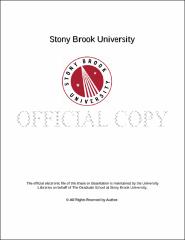| dc.identifier.uri | http://hdl.handle.net/11401/76203 | |
| dc.description.sponsorship | This work is sponsored by the Stony Brook University Graduate School in compliance with the requirements for completion of degree. | en_US |
| dc.format | Monograph | |
| dc.format.medium | Electronic Resource | en_US |
| dc.language.iso | en_US | |
| dc.publisher | The Graduate School, Stony Brook University: Stony Brook, NY. | |
| dc.type | Dissertation | |
| dcterms.abstract | As in many other stratified bodies of water, microbial chemoautotrophic productivity in the anoxic Cariaco Basin is a major source of fixed carbon across the oxic-anoxic boundary yet the identity of the chemoautotrophic microbes and what fuels their metabolism are poorly understood. In this work, multiple techniques were used to investigate the distribution, abundance, and activity of major proteobacterial and archaeal clades during nine cruises from 2006 to 2010 in order to identify the dominant chemoautotrophs. Among seven clades examined in this study by fluorescence in situ hybridization (FISH), epsilonproteobacteria and betaproteobacteria were the prevalent clades and on average accounted for about 15 and 10 % of the total prokaryotic community in the redoxcline, respectively. Other bacterial clades (gammaproteobacteria, alphaproteobacteria, and sulfate-reducing deltaproteobacteria) on average accounted for 4-6 % and archaeal clades (Thaumarchaeota and Euryarchaeota) for 4-8 % of the total community in the redoxcline, depending on location. Non-parametric permutational multivariate analysis of abundances of all clades showed significant variability in the prokaryotic community distributions among cruises. Abundances of epsilonproteobacteria, gammaproteobacteria, and betaproteobacteria exhibited strongest covariations with intermediate sulfur species (thiosulfate, sulfite, elemental sulfur). Distributions of thiosulfate alone accounted for 13-55 % of variance in distributions of epsilonproteobacteria and 15 % in betaproteobacteria. Distributions of sulfite alone accounted for 21 and 35 % of variance in distributions of gammaproteobacteria and betaproteobacteria, respectively. Distributions of elemental sulfur alone accounted for 20 % of variance in distributions of gammaproteobacteria. These results suggest that members of these clades are mostly thiotrophic. Findings from this study also suggest that the Cariaco Basin's redoxcline is a site of dynamic geochemistry and prokaryotic community. A study of the effect of bacterivory and excess of selected sulfur substrates on the activity of the clades showed preferential grazing on alphaproteobacteria while abundances of other clades increased regardless of the presence or absence of the bacterivorous grazers. Addition of H2S/NO3- stimulated growth of epsilonproteobacteria and Thaumarchaeota while addition of H2S/Mn(IV) stimulated growth of Thaumarchaeota in the presence or absence of predators. Growth of other clades either did not change significantly compared to unamended samples or was inhibited by these additions. Microautoradiography combined with FISH showed active uptake of <super>14</super>C-bicarbonate by up to 26 % of the total prokaryotic community in the upper anoxic layer. In samples amended with just <super>14</super>C-bicarbonate, gammaproteobacteria accounted for 44-50 % of all gammaproteobacterial cells. In samples amended with H2S/Fe(III), epsilonproteobacteria, gammaproteobacteria, and Thaumarchaeota accounted for 91, 14, and 80 % of all probe-positive cells, respectively. In samples amended with S2O32-/NO3-, epsilonproteobacteria accounted for up to 25 % of all epsilonproteobacterial cells. These findings signify that these prokaryotes are chemoautotrophs with thiotrophic metabolism. <super>13</super>C/<super>15</super>N-DNA stable isotope probing combined with terminal restriction fragment length polymorphism (TRFLP) and cloning and sequencing of bacterial 16S rRNA genes resulted in identification of epsilonproteobacteria closely related to the genus <italic>Sulfurovum</italic> and a demonstration of their chemoautotrophic activities with H2S and S2O32- as energy substrates and NO3-, Fe(III), or Mn(IV) as oxidants. In summary, this work has shown that epsilonproteobacteria closely related to the genus <italic>Sulfurovum</italic> might represent the dominant chemoautotrophs in the Cariaco Basin's redoxcline and yet unidentified representatives of chemoautotrophic gammaproteobacteria and Thaumarchaeota are active in this system as well. These chemoautotrophs are capable of obtaining energy from reduced sulfur species and use nitrate or metal oxides as electron acceptors. | |
| dcterms.available | 2017-09-20T16:49:38Z | |
| dcterms.contributor | Scranton, Mary | en_US |
| dcterms.contributor | Taylor, Gordon T | en_US |
| dcterms.contributor | Collier, Jackie L | en_US |
| dcterms.contributor | Aller, Robert | en_US |
| dcterms.contributor | Kerkhof, Lee. | en_US |
| dcterms.creator | Podlaska, Agnieszka | |
| dcterms.dateAccepted | 2017-09-20T16:49:38Z | |
| dcterms.dateSubmitted | 2017-09-20T16:49:38Z | |
| dcterms.description | Department of Marine and Atmospheric Science. | en_US |
| dcterms.extent | 181 pg. | en_US |
| dcterms.format | Monograph | |
| dcterms.format | Application/PDF | en_US |
| dcterms.identifier | http://hdl.handle.net/11401/76203 | |
| dcterms.issued | 2013-12-01 | |
| dcterms.language | en_US | |
| dcterms.provenance | Made available in DSpace on 2017-09-20T16:49:38Z (GMT). No. of bitstreams: 1
Podlaska_grad.sunysb_0771E_11701.pdf: 4442224 bytes, checksum: 0fa23c042ff05687c015372fd67c98fe (MD5)
Previous issue date: 1 | en |
| dcterms.publisher | The Graduate School, Stony Brook University: Stony Brook, NY. | |
| dcterms.subject | Environmental science | |
| dcterms.title | A culture-independent study of dominant sulfur-utilizing chemoautotrophs within the Cariaco Basin's redoxcline | |
| dcterms.type | Dissertation | |

